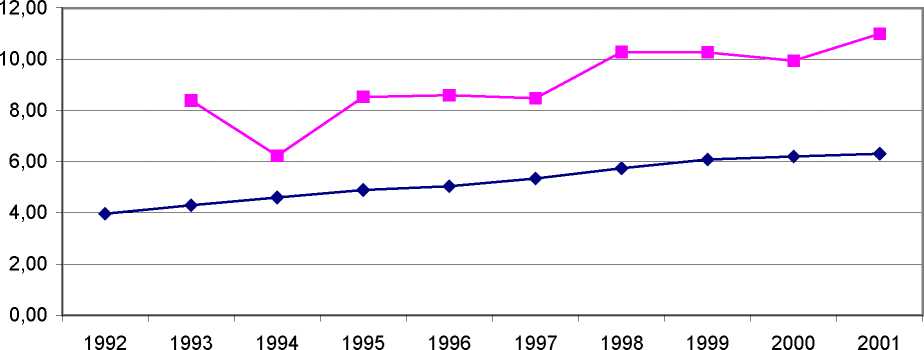Figure 3.7
Average Households Prices for Urban and Rural (Altiplano) La Paz
(cents $/kWh)

La Paz H La Paz - Altiplano
Source: INE
The pattern of behaviour above in terms of the evolution of urban and rural prices is the same in
other departments of the country. Consistently, rural prices tend to be higher and grow at a faster
rate than urban prices, regardless of whether one is analyzing the period before or after
regulation. This situation suggests that while there might have been positive marginal effects on
coverage and prices of privatization and regulation in urban Bolivia, rural Bolivia has basically
remained the same after the transformation of this industry. This finding is consistent with
previous studies that showed rural Bolivia stagnant, with no clear downward trend on poverty
indicators due to greater access, at cheaper prices, of basic services such is electricity. Greater
coverage, along with more affordable prices of this commodity, is something that has simply not
happened in rural Bolivia, and it feeds on the belief that privatization and regulation of public
utilities - electricity, in the present case - have hurt the poor.
Even when the analysis above is disaggregated by operator throughout the country, the same
pattern of behaviour remains, as is clear in Figure 3.8 below, where the evolution of tariffs for
different groups of operators13 is illustrated.
13Group 1 includes the biggest distributors of electricity in the country. Their abbreviated names and serving areas (in
parenthesis) are as follows: Electropaz (La Paz), Cre (Santa Cruz), and Elfec (Cochabamba). Group 2 is composed of
16
More intriguing information
1. The name is absent2. REVITALIZING FAMILY FARM AGRICULTURE
3. The name is absent
4. Types of Tax Concessions for Promoting Investment in Free Economic and Trade Areas
5. Heterogeneity of Investors and Asset Pricing in a Risk-Value World
6. The name is absent
7. Estimating the Economic Value of Specific Characteristics Associated with Angus Bulls Sold at Auction
8. Quality Enhancement for E-Learning Courses: The Role of Student Feedback
9. The name is absent
10. Nonlinear Production, Abatement, Pollution and Materials Balance Reconsidered